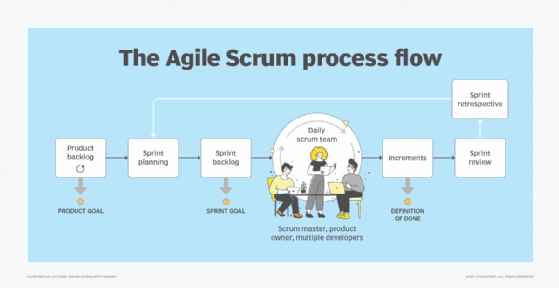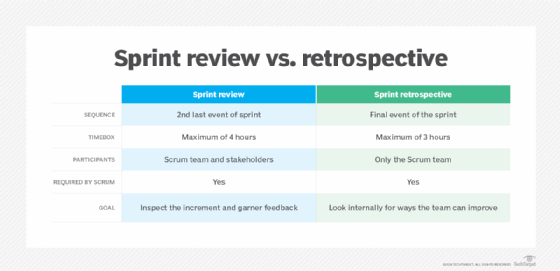Sprint review vs. retrospective: What's the difference?
The key difference between the Scrum sprint review and retrospective is that in the review the Scrum team can reach out to the stakeholders and share their progress, while the sprint retrospective is for the team to look inward and find opportunities for improvement and change.
What is the sprint review?
The goal of every sprint in Scrum is to produce something of value that contributes to the final product. Each time a product backlog item is completed and meets the organization's agreed-upon definition of done, an increment is born. In Scrum, products are built incrementally.
The purpose of the sprint review is to present to clients and stakeholders every increment produced during the current sprint and how it integrates with the existing product. During the sprint review, stakeholders interact with the product and its enhancements and provide feedback; based on that feedback, the Scrum team adapts.
Inspection and adaptation are essential
The sprint review is more than just a demo. Stakeholders are expected to use the product, interact with it, test it, and even try to break it. Feedback loops are a critical part of an Agile process, so teams must gather as much honest feedback as possible during the sprint review.
Inspection and adaptation are two of the three pillars of Scrum. Inspection by the client and adaptation by the Scrum team are precisely what the sprint review is all about.
As the 2020 Scrum Guide itself proclaims: "The purpose of the Sprint Review is to inspect the outcome of the Sprint and determine future adaptations."

However, feedback isn't always easy to take. When things go well, the sprint review can feel like a victory party. When it goes poorly, it can feel like a bad breakup. Regardless of how your sprint review goes, the sprint retrospective is a good time to talk about what happened during the sprint.
What is a sprint retrospective?
The sprint retrospective is the last event in a Scrum sprint. When the sprint retrospective ends, a new sprint begins.
There are no strict rules about who can attend the sprint retrospective. One of the five Scrum values is openness, so blocking anyone from attending the sprint retrospective runs counter to the Scrum Guide. However, in practice, usually only members of the Scrum team actively participate in the sprint retrospective.
During the sprint retrospective, the scrum master, product owner, and developers discuss what worked and what didn't. According to the Scrum Guide: "The purpose of the Sprint Retrospective is to plan ways to increase quality and effectiveness."
The focus of the sprint retrospective includes topics such as the tools used, the team's interactions, and how the Scrum framework was applied.
During the sprint retrospective, the team also looks for ways to increase their effectiveness in future sprints.
Sprint retrospective best practices
While not explicitly prescribed by the Scrum Guide, a common practice on many Scrum teams is to identify the most significant change they believe they can make to their practices and processes, and commit to incorporate that in the next sprint.
The belief is that over a six- to 12-month project, the compounding effect of an additional new productive practice with each sprint will help the team become highly effective.
Sprint review and retrospective differences
As you can see, the sprint review and the sprint retrospective have very different focuses and purposes. The sprint review is conducted in front of the stakeholders and presents the progress made during the sprint, while the sprint retrospective is a time for the Scrum team to reflect on their own processes and identify ways to improve as a team.

Darcy DeClute is a certified scrum master, product owner and scrum developer. She is also the author of the Scrum Master Certification Guide.


